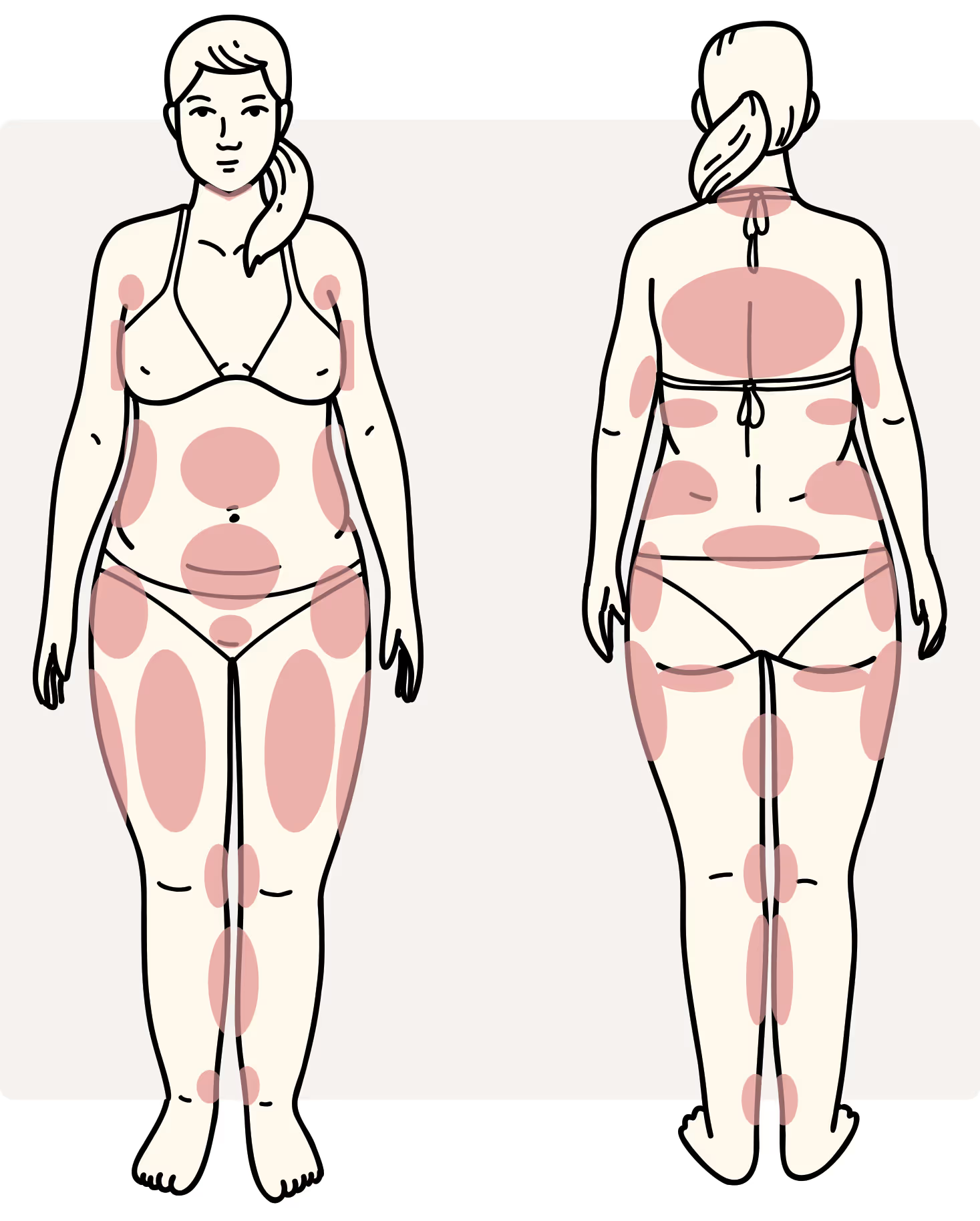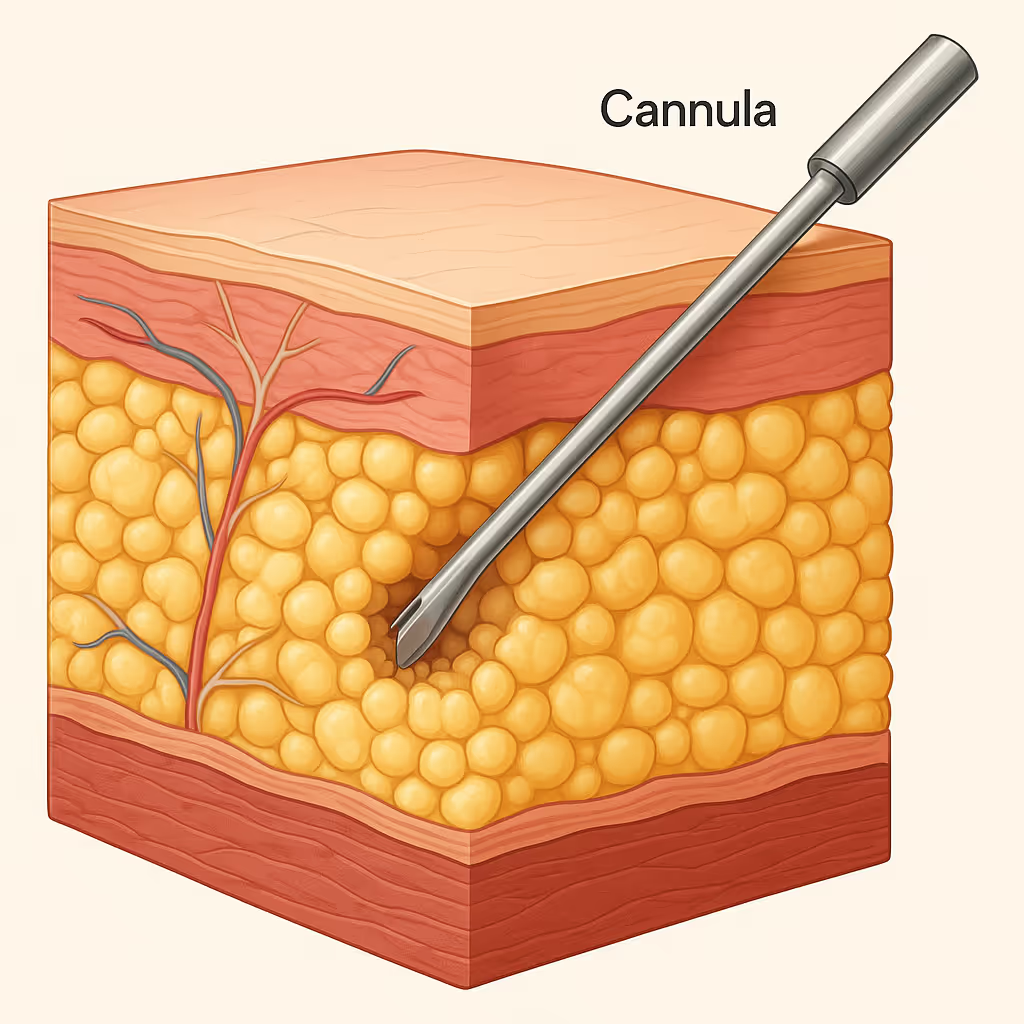What is Liposuction?
Liposuction — also called suction-assisted lipectomy (SAL) — is a surgical procedure designed to remove excess fat from specific areas of the body using a cannula (thin tube) connected to a vacuum.
The goal of liposuction is not weight loss, but body contouring — improving shape, proportion, and silhouette by removing stubborn fat pockets that don’t respond to diet or exercise.
Think in inches, not in kilos. Liposuction changes your silhouette, not your scale.
Liposuction is often combined with other procedures such as:
- Tummy tuck (abdominoplasty)
- Arm lift (brachioplasty)
- Thigh lift
- Breast reduction
- Fat transfer (e.g. to buttocks or breasts)
In some cases, liposuction is also used for medical purposes:
- Gynecomastia (male breast reduction)
- Lipedema and lipodystrophy syndromes
- Benign lipomas or fatty overgrowths
It’s important to note that liposuction does not treat cellulite or loose skin, and it won’t change your overall weight dramatically. It’s a sculpting tool, not a weight-loss solution.
What Areas Can Be Treated with Liposuction?
Liposuction is highly versatile and can target many common problem zones, including:
- Abdomen (upper, lower, and waist)
- Flanks / Love handles
- Outer and inner thighs
- Hips and buttocks
- Upper arms
- Back (including bra rolls)
- Chin and neck
- Chest (male gynecomastia)
- Knees and ankles

Who is a Good Candidate for Liposuction?
Liposuction is most effective in patients who:
- Have localized fat deposits that resist diet and exercise
- Are near or at their ideal body weight
- Have good skin elasticity (so the skin can retract after fat is removed)
- Do not smoke, or are willing to stop for the procedure and recovery
- Have realistic expectations about what the procedure can and cannot do
Do the pinch test: if your skin snaps back quickly when pinched, you likely have good elasticity for a smooth result.
Not everyone is an ideal candidate for liposuction, and even small differences in skin elasticity or fat distribution matter.
Find certified surgeons who offer personal evaluations →
It’s not suitable for:
- People with significant loose or sagging skin
- Individuals seeking general weight loss
- Patients with uncontrolled medical conditions (e.g. diabetes, clotting disorders)
- Women who are planning a pregnancy soon (as results may change)
If skin laxity is a concern, combining liposuction with skin tightening procedures — or using radiofrequency-assisted methods — may be a better solution.
What Are the Benefits of Liposuction?
- More defined and balanced body proportions
- Smooth silhouette and improved fit in clothing
- Permanent removal of fat cells in treated zones
- Very small scars (typically 2–4 mm)
- Boost in confidence and body image
- Can complement other surgeries or fat grafting procedures
When performed by an experienced surgeon, liposuction can create natural-looking results that last for years — especially if you maintain a stable weight.
How Liposuction Works (Step-by-Step)
Preparation
The procedure begins with marking the treatment areas and taking photos. Patients may receive local anesthesia (for small areas), regional anesthesia, or general anesthesia depending on the volume and zones being treated.
Infiltration
A sterile solution is injected into the fat. This “tumescent” fluid:
- Numbs the area (via lidocaine)
- Constricts blood vessels (via adrenaline)
- Helps loosen fat and minimize bleeding
Fat Removal
The surgeon inserts a small cannula through 2–4 mm incisions. The cannula is connected to a vacuum that suctions out fat through back-and-forth movements. The surgeon sculpts the area gradually while checking symmetry and contour.

Closure & Compression
Incisions may be left open to drain fluid or closed with sutures. A compression garment is applied to reduce swelling and help skin retract.
The entire procedure typically takes 1 to 3 hours, depending on how many zones are treated.
Liposuction Techniques: Traditional vs Modern Methods
While this article focuses on traditional suction-assisted liposuction (SAL), it’s useful to understand the key variants — especially if you’re comparing clinics or deciding between treatment options.
Each method has its advantages, but SAL remains widely performed technique in Belgium and globally due to its simplicity, safety profile, and excellent results in the hands of experienced surgeons.
Want to dive deeper into each technique?
Learn more about the technologies mentioned above and how they compare:
From traditional SAL to HD lipo or PAL, each technique requires different expertise.
Explore surgeons experienced in multiple lipo methods →
Recovery Timeline & Aftercare
Days 1–7
- Swelling, bruising, and fluid drainage are common
- Pain is usually mild to moderate and well-controlled with medication
- Wear compression garments 24/7
- Short walks are encouraged to reduce risk of blood clots
Weeks 2–4
- Most patients return to non-physical work in 5–10 days
- Bruising starts to fade
- Compression garments are worn continuously, then daytime only
Weeks 5–12
- Swelling continues to resolve
- Light exercise may resume (with clearance)
- Shape begins to stabilize
Some surgeons recommend manual lymphatic drainage (MLD) massage starting in week 1 to accelerate swelling reduction and reduce the chance of unevenness.
Final Results
- Initial results: 3–4 weeks
- Full results: 3–6 months
- Swelling may linger in ankles, thighs, or abdomen (esp. after high-volume lipo)
Risks and Possible Complications
Liposuction is a safe procedure in experienced hands, but like all surgeries, it carries some risks:
- Contour irregularities (dimpling, asymmetry)
- Skin laxity in patients with poor elasticity
- Bruising and swelling (common but temporary)
- Fluid collections (seromas)
- Temporary numbness or altered sensation
- Fat embolism (rare but serious)
- Infection (very rare with proper hygiene)
In rare cases, a second "revision" liposuction may be needed to correct irregularities or asymmetry. Revision lipo is usually more complex than the first surgery.
Most complications can be avoided through proper technique, patient selection, and close aftercare. Always choose a board-certified plastic surgeon with experience in body contouring.
How Long Do Liposuction Results Last?
Liposuction permanently removes fat cells from the treated areas. However, the remaining fat cells can expand if you gain weight. For long-term results:
- Maintain a stable weight
- Avoid crash dieting or large weight fluctuations
- Exercise regularly and eat a balanced diet
If you gain significant weight after liposuction, your body may store fat in new or untreated areas.
Liposuction in Belgium: Prices and Practical Info
- Starting price: Around €1200 per zone
- Multiple zones: Expect €1800–3000+
- Consultation fees and compression garments may be billed separately
- Some clinics offer packages combining liposuction with skin tightening or fat transfer
When comparing surgeons, don’t focus solely on price. Experience, technique, and safety matter more than discounts.
Find a trusted doctor →
Final Thoughts
Liposuction is one of the most effective and reliable tools in modern aesthetic surgery. When performed safely and tailored to your body, it can dramatically improve your shape and help you feel more confident in your skin.
Whether you’re just exploring your options or ready to meet a surgeon, learning about the techniques, limitations, and recovery process will help you make an informed, empowered decision.
Liposuction in Brussels / Liposuction in Antwerp / Liposuction in Charleroi


